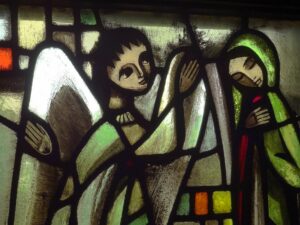 Mary, full of grace!
Mary, full of grace!
For the feast day today we would like to consider some words of this biblical scene as Fr. Joseph Kentenich presented it in a sermon for the German community in Milwaukee / USA on January 10, 1965. He said:
“The Ave in her ear (Lk 1:26-38).
From whom does the Ave come? From the dear God himself. So who sends greetings to the Blessed Mother? The Eternal God, the Triune God through a messenger. And the theologians have placed great weight on emphasizing that the angel does not formally and immediately come with a commandment, but with a request. So the dear God addresses the free will of the dear Blessed Mother: ‘Do you want?’ We want that. ‘Are you ready?'” (Living by Faith 16, page 76/77)
How reverent and empathetic God is when he turns to us. Have we understood his beckoning with attention and faith? Have we responded to him?
On October 18, 1914, the hour of the Annunciation was renewed in a special way in Schoenstatt. It is a new “hour of proclamation for the Blessed Mother and for us!” For the dear Blessed Mother it is a divine mission:
to bring Christ into the Shrine and from the Shrine out of the world!
The Shrine becomes Nazareth for our time. Here the eternal wisdom unites the “yes” of Mary, Mother Thrice Admirable of Schoenstatt, with the “yes” of Father Kentenich. Starting from this covenant of love, Schoenstatt begins to beat in the heart of the Church, becoming a “beacon” for the Church and the world.

On the feast day of the Annunciation of the Lord, we too—filled with grace– are animated to discover, like the Blessed Mother, the messages of God in our lives. God speaks to us in every moment. We must be attentive and give our response.
How does God speak to us? What is our response? Also the effectiveness of the covenant of love, the salvation of many depends on our yes.
Father continues: “So what did she do? The same thing that we always have to do when we ask the question whether and how and when and where the dear God somehow expresses a wish. There are three points: first, she thought about what the angel was telling her. […] She had probably never thought that she should be chosen to become the Mother of the Eternal Word, the Redeemer. She thought about it. And after she hadn’t come up with anything herself, she asked: How is that supposed to happen? And after she has received an answer – albeit a peculiar answer – to the how – what is the answer? With God nothing is impossible; simply the reference to the omnipotence of God – the spirit is satisfied, then she says her sincere and heartfelt “Yes”. (Ibid., 77/78)
And Fr. Kentenich draws the conclusion: “Devout listeners, what would we be without this Annunciation scene? What would have become of the world, of us, if the Blessed Mother had not said yes in the name of human society, of human nature? (Ibid., 78)
The Holy Father, Pope Francis, invites us to consider this attitude of Mary: “Decision is the third step which characterizes every Christian vocation, and it is expressed in the answer which Mary gives the angel: ‘May it be done to me as you have said’ (v. 38). Her ‘yes’ to God’s plan of salvation, realized through the Incarnation, is the offering of one’s whole life to Him. It is the ‘yes’ of full trust and total obedience to the will of God. Mary is the model for every vocation; she inspires every pastoral work for vocations: the young people who are searching or who ask themselves about their future can find in Mary that which helps them to find God’s plan for themselves and the strength to agree to it”. (Visit of Pope Francis to Loreto, March 25, 2019)